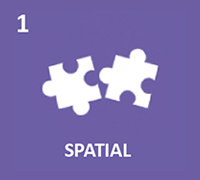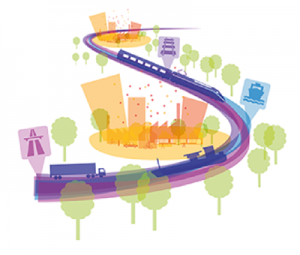Our ambition
Achieving a smart, green and integrated transport system is key to sustaining and developing the economic, social and environmental vitality of urban Europe. Within this context, the challenge is to deliver a practical and consistent approach that enables the synergetic integration of spatial development with investments in infrastructure across all relevant scales. This integrated NUVit approach aims at an adaptable, sustainable and future-proof transport network that delivers optimal conditions for accessible, safe, economic viable, vital and connected functional urban areas.
In this perspective, our ambition is to create a continuously expanding network of active participants to strengthen international cooperation and knowledge exchange regarding the NUVit approach.


Based on group discussions with international experts, the basic framework of NUVit has been developed and validated. The framework distinguishes six dimensions: spatial, network, temporal, value, institutional and implementation. Although many other categorisations are possible, we consider these six dimensions being characteristic of land-use and infrastructure planning. The value of the basic framework is the synergetic integration of these six closely related dimensions. Vitality is the heart of the model.

An integrated approach towards these dimensions can reveal synergetic aspects that may go beyond the sectorial project scope. These effects can influence the economic, environmental and social vitality of the region. NUVit stands for an integrated approach, in which vitality is discussed consistently during the planning process.
|

Spatial dimension: Spatial concepts with synergetic effects on accessibility
For this dimension, critical aspects are the ability to deal with scale issues, the role of transport analysis and spatial design. The latter is both a strategic and operational tool. This is achieved by implementing integrative spatial agglomeration and transport concepts. Well-known examples of such integrative concepts are Transit-Oriented Development (TOD), Multimodal corridors, Nodal development, Area-oriented approach, Borrowed Size.
|
|

Combined value creation and capturing
This dimension provides an overview of state of the art models and approaches to assess value (e.g. Cost-Benefit Analysis; Life-Cycle Assessment; Environmental Impact Assessment), to create value (including accessibility) and to capture value in combined infrastructure and spatial development (projects).
|
|

Multimodal network optimisation at various spatial scales
This dimension aims at establishing the main parameters of specific transport systems (multimodality, land-use transport integration, LUTI) in relation to spatial functions and spatial density. Different levels of spatial scales are relevant: corridors at (inter)national level, daily urban systems at metropolitan level and landscaping at local level.
|
|

Organisational empowerment for integrated planning
This dimension comprises analysing existing organisational and institutional frameworks, to provide an overview of governance approaches at all levels for the implementation toolbox. This relates to a broad array of concepts regarding institutional embedding, capacity, culture and setting and governance models. It also entails development of governance approaches for different situations (transport-land-use combinations) related to partnerships: inter-governmental cooperation, market involvement, stakeholder engagement, and organisational networks.
|
|

Time linkages and shift to strategy driven planning
his dimension aims at linking the stages in a full life-cycle of places (this also relates to renewal, redevelopment, circular economy and asset management), examining paradigms and temporal changes associated with changing lifestyles and linkages to mobility and accessibility. It also consists of an analysis and review of time linkages for strategy development, regarding the development of transport infrastructure systems and transitions to multi-modality.
|
|

Implementation drivers for integrated planning
Finally, a critical aspect in innovation is the deployment and the implementation. Therefore, in NUVit, explicit attention is paid to the implementation of the framework developed. This dimension includes making an inventory of implementation issues and drivers in order to tackle implementation barriers.
|
 |
 |
 |



1. The scale of the European corridors
In some TEN-T clusters traffic is prospected to quadruple. This puts a strain on the related infrastructures. At the same time such development can result in positive spin-off effects on a local scale. Good practices show infrastructure can be co-developed with water, climate and spatial quality issues.

|
|

2. The scale of the functional urban area
The highest level of synchromodality can be seen within the so-called Daily Urban Systems (DUS). In these DUS mobility is enabled by different infrastructure networks and a variety of multimodal nodes. In the TEN-T clusters the trans-European traffic (both persons and freight) shares capacity and interacts with the DUS (e.g, urban highway ring roads). Therefore, the DUS is fundamental in optimising transport infrastructure and land-use planning. On a systems level the DUS is crucial for economic cohesion and health issues.
On the main infrastructure lines in the region, these DUS traffic flows coincide with the traffic that moves on the level of the European corridors. The regional scale is crucial to manage strategically different modalities, different infrastructure scales and the land-use around the multimodal nodes. For example, the case Rotterdam (ring road) and Luxembourg (Plateau de Kirchberg) show that the congestion on the main infrastructure can be reduced by interventions on infrastructures on a lower scale and by enhancing other modalities elsewhere in the regional system.

|
|

3. The scale of a specific location
On this scale, integrated land-use planning and infrastructure planning enable capture of the highest mobility, logistics (freight), land use and economic value. Moreover, optimal spatial design and embedding of large infrastructures can improve the spatial and vital (a.o. environmental) quality for residents and businesses.

|
Five types of challenges in the field of land-use planning and infrastructure planning, as described by NUVit, can be identified in a broad number of regions across Europe. These typologies are the outcome of three TIILUP/NUVit prologue workshops and an assessment made by the core group.
 An integrated approach towards these dimensions can reveal synergetic aspects that may go beyond the sectorial project scope. These effects can influence the economic, environmental and social vitality of the region. NUVit stands for an integrated approach, in which vitality is discussed consistently during the planning process.
An integrated approach towards these dimensions can reveal synergetic aspects that may go beyond the sectorial project scope. These effects can influence the economic, environmental and social vitality of the region. NUVit stands for an integrated approach, in which vitality is discussed consistently during the planning process.










 Large scale infrastructure concentration is a primary segment of the European Networks. In many situations, international (freight) traffic and local traffic are competing for the same space and capacity on the infrastructure.
Large scale infrastructure concentration is a primary segment of the European Networks. In many situations, international (freight) traffic and local traffic are competing for the same space and capacity on the infrastructure.
 Development of Hubs will interlink different modalities. In this way, capacity can be exchanged between the different networks and a more stable mobility network is developed. However, giving space to hub development can lead to local environmental issues, spatial barriers and negatively impact living qualities.
Development of Hubs will interlink different modalities. In this way, capacity can be exchanged between the different networks and a more stable mobility network is developed. However, giving space to hub development can lead to local environmental issues, spatial barriers and negatively impact living qualities.
 Concurrent growth of a region and an infrastructure corridor often leads to tension. Especially when the infrastructure growth cannot be harmonised with the available space and current spatial form (barrier). In order to create synergistic effects, co-development of infrastructure measures and urban (re)development is required.
Concurrent growth of a region and an infrastructure corridor often leads to tension. Especially when the infrastructure growth cannot be harmonised with the available space and current spatial form (barrier). In order to create synergistic effects, co-development of infrastructure measures and urban (re)development is required.
 In some areas, spatial (re)development focuses on the existing urban area. Additional spatial development combined with corridor development can lead to ‘cannibalization’ of the (re)development potential of the existing city. This asks for a consolidation of the corridor in order to maximize spatial quality potential.
In some areas, spatial (re)development focuses on the existing urban area. Additional spatial development combined with corridor development can lead to ‘cannibalization’ of the (re)development potential of the existing city. This asks for a consolidation of the corridor in order to maximize spatial quality potential.
 A declining population or economy in formerly booming areas can lead to the situation that the infrastructure lay-out does not fit the land-use anymore. A transformation of parts of the existing, but out-of-use, infrastructure is needed to generate a vital regional future.
A declining population or economy in formerly booming areas can lead to the situation that the infrastructure lay-out does not fit the land-use anymore. A transformation of parts of the existing, but out-of-use, infrastructure is needed to generate a vital regional future.